SUMMER
GAMES
Summer Games
Atari Corp.
1196 Borregas Avenue
Sunnyvale, CA 94086
(408) 745-2000
$39.95; XL/XE Cartridge
Reviewed by Matthew J.W. Ratcliff
Summer Games
Atari Corp.
1196 Borregas Avenue
Sunnyvale, CA 94086
(408) 745-2000
$39.95; XL/XE Cartridge
Reviewed by Matthew J.W. Ratcliff
Summer Games from Epyx will take you back to the summer of 1984 to compete in eight different simulations of platform diving, pole vaulting, gymnastics, freestyle relay and 100-meter freestyle swimming, 4x400meter relay, 100-meter-dashrunning and skeet shooting. The graphics are fairly good, but all the characters are two-tone blocky animations. This is a valiant effort to simulate the grandeur and excitement of the Olympic Games, but some events are little more than animations with you as a spectator.
You will employ two basic joystick functions while participating in the Summer Games. Most events require precise movements of the stick or actuation of the fire button in specific sequences. Minute variations mean complete failure. The 100-yard dash requires brute-force toggling of the joystick at a ferocious rate to generate speed. The longer events require constant manipulation of the joystick by rote, which quickly becomes tedious.
Players may compete in all eight events or a single one, taking turns in all except the 100-meter dash and freestyle swimming, where two can compete head to head. When starting a competition, up to three players may select names and a country to represent. There are flags and national anthems presented for up to nine different countries. If you prefer, you may select any single event for practice to hone your skills for the next big contest.


In the pole-vault event, you are presented with a side view of the track, vault and pit. You select bar height and grip position on the pole. On the approach, you pull the joystick down to plant the vaulting pole. This timing must be exact for a good launch. This is followed by a rapid succession of joystick gyrations and a delicately timed release of the pole. If you let go too soon, your man hits the bar; too late, and the pole will hit the bar. The timing sequence is extremely difficult to master.
Platform diving is my favorite of the Summer Games simulations. In competition, each player must perform a forward, backward, reverse and inward dive for a score based on quality and difficulty factor. The joystick directions may be used to control tuck, pike, half-pike and full-layout positions. A high score is awarded for many spins and a vertical entry, either hands or feet first. Once in the air, you select the spin rate by choice of position and finally move to a full-layout position for a hopefully vertical entry. A score is calculated based on difficulty factor and total points awarded by seven judges. Joystick controls for this simulation are logical and easily timed, and the graphic animations of the spinning diver are well done.
The 4x400-meter relay is designed to be a race of strategy. Each runner starts at a normal running speed, with a small horizontal bar at the bottom of the display representing his "wind." The longer the bar, the stronger the runner. Careful control of the joystick among normal running, coasting and sprinting is required to optimize each runner's performance. Each has a different strength. The runner of the final leg is the best sprinter, for example. This is an accurate simulation of a genuine relay race, but the joystick inputs don't seem to have much control over the final outcome.
The 100-meter dash will test the limits of your joystick handle and your wrist. Wiggle the joystick horizontally or vertically as fast as possible. The faster the stick moves, the faster your character runs.
In the gymnastics simulation, you will attempt a vault from a springboard to the horse and then to the floor. For a high score you must spin in all sorts of ways and land flat-footed. This event requires painfully accurate timing. To get a good vault off the horse, the fire button must be pressed at the precise moment. Miss it, and you can forget about getting any rotation--or much of a score for that matter. I managed to hit it exactly once out of at least 50 attempts. This simulation is just plain frustrating.
In the freestyle relay you must swim four laps, changing swimmers at the end of each lap. The 100-meter freestyle is identical, except with a single swimmer and only one lap. In these events you press the fire button in time with the swimmer's stroke for a minuscule boost of power. At each turn, change the swimmer's direction with the joystick at just the right moment for a fast turn. Pressing the fire button to the precisely timed metronome of the swimmer's stroke is tiresome and seems to make little difference. In fact, if you do nothing at all in the 100-meter freestyle, the swimmer will complete the race all by himself.
Skeet shooting is the final event of the competition. You control a circular gun sight, which indicates where the buckshot will hit when the trigger is pressed. You must react quickly and accurately as each target is launched. If you waver even slightly from a perfect beeline to the clay pigeon's path, there will not be enough time to catch up and shoot.
The opening and champion ceremonies, which round out the Summer Games package, are nicely done animations. This game is too neatly "packaged," however. The events are precisely sequenced with little or no variation allowed. You will spend more time simply watching than actively participating.
Summer Games may prove entertaining while the graphics and action sequences are new to you. After that, however, it degrades rapidly into a boring and tedious collection of monotonous simulations.
The author wishes to thank Randall's Home Computers of St Louis, Missouri, for their valuable assistance in preparing this review.

Matthew J.W. Ratcliff is an electrical engineer at McDonnell Aircraft in St. Louis.